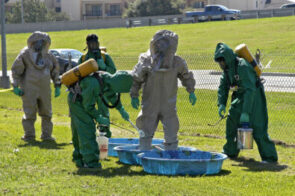OSHA Training: 5 Facts About the HAZWOPER Standard
January 6, 2015
The Hazardous Waste Operations and Emergency Response (HAZWOPER) Standard
The Occupational Safety and Health Administration’s (OSHA) Hazardous Waste Operations and Emergency Response (HAZWOPER) standard applies to employers and employees who m be exposed to hazardous waste during routine handling, treatment, disposal, and cleanup or remediation. According to OSHA, the five distinct groups which are specifically covered by HAZWOPER are:
- clean-up operations—required by a governmental body, whether federal, state, local, or other involving hazardous substances – that are conducted at uncontrolled hazardous waste sites;
- corrective actions involving clean-up operations at sites covered by the Resource Conservation and Recovery Act of 1976 (RCRA) as amended (42 U.S.C. 6901 et seq.);
- voluntary clean-up operations at sites recognized by federal, state, local, or other governmental body as uncontrolled hazardous waste sites;
- operations involving hazardous wastes that are conducted at treatment, storage, and disposal facilities regulated by Title 40 Code of Federal Regulations Parts 264 and 265 pursuant to RCRA, or by agencies under agreement with U.S. Environmental Protection Agency to implement RCRA regulations; and
- emergency response operations for releases of, or substantial threats of releases of, hazardous substances regardless of the location of the hazard.
Related Article: OSHA 2015 Regulatory Changes: Will You Be Ready?
1. There are 3 different levels of the HAZWOPER training course.
The three different HAZWOPER courses are as follows:
- 40-Hour Training Class;
- 8-Hour Training (Refresher) Class; and
- 24-Hour Training Class.
The first and most intensive training course is the 40-hour class. This training course must be taken by those who are working on-site for hazardous waste cleanup and remediation. Also, some companies may require HAZWOPER training along with requisite EPA, RCRA, or general OSHA courses for its instructors and first-response personnel.
After the initial HAZWOPER training class has been taken, a refresher course (8 hours long) needs to be attended every year thereafter by hazardous waste employees. And the third level HAZWOPER training is the 24-hour course. This level of training must be completed by those whose job is to visit or inspect uncontrolled hazardous waste cleanup sites.
2. The 8-Hour Annual Refresher Course May be Taken in Segments.
The annual refresher course can be broken up into smaller durations, so long as the total 8 hours is completed by the anniversary date of the employee’s initial HAZWOPER (or previous refresher) course. If this 8-hour class cannot be completed within the 12 month period stated by OSHA, the reason for the delay should be filed in the employee’s records, and the next possible course should be attended. Computer-based or online refresher courses can count toward proper certification, but they may also need to be supplemented by relevant hands-on training.
3. OHSA provides exemptions for HAZWOPER training for those employees who are not expected to engage in emergency response or cleanup.
If you are a large quantity generator (LQG) and you have a spill response contingency plan which mandates that all employees should evacuate the premises in case of an accidental spill or emergency, and then call the fire department or a spill response company to deal with the spill’s containment and remediation, your company can be exempted from HAZWOPER training.
4. On-site workers, such as utility or construction workers, must take training if there is an expected chance of site contamination.
You may have many on-site workers on your premises doing various jobs that are unrelated to hazardous waste treatment. But in the case of an emergency, these workers must have the proper HAZWOPER training to continue to be on-site. Once the contamination is cleared or once the threat has become minimal, however, workers with less training and personal protective equipment (PPE) may be allowed back on-site.
5. Hospital staff must pass job safety training—but the HAZWOPER training class isn’t always necessary for all healthcare workers.
HAZWOPER requires all hospital employers to certify that staff has some level of training, whether in the HAZWOPER class itself (though this is not necessary for all hospital workers), or in PPE instruction, decontamination, or first-response operations. As long as some competency in hazardous materials (HAZMAT) emergency safety can be demonstrated, the level of training for different members of staff at a hospital may vary.
Photo credit: wikimedia commons
All of OSHA’s rules, including the HAZWOPER standard, are important to ensure safety for all workers. If you are new to generating hazardous waste and would like to know more about industry and safety regulations, standards, and best practices, call us today at 800-936-2311 to speak with an expert or click here to email us.


